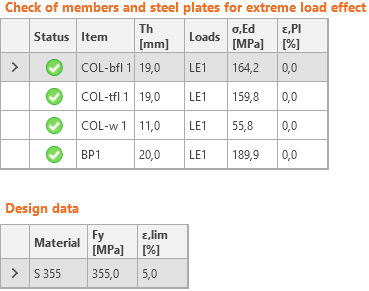Code-check of steel plates (EN)
The resulting equivalent stress (Huber-Mises-Hencky – HMH, von Mises) and plastic strain are calculated on plates. The elasto-plastic material model is used for steel plates. A check of an equivalent plastic strain is performed. The limiting value of 5 % is suggested in Eurocode (EN 1993-1-5, app. C, par. C8, note 1), this value can be modified by the user in Code setup.
The plate element is divided across its thickness into five layers of finite element shells, and elastic/plastic behavior is investigated in each layer separately. Output summary lists the most critical check from all five layers.
CBFEM method can provide stress rather higher than yield strength. The reason is the slight inclination of the plastic branch of the stress-strain diagram, which is used in the analysis to improve the stability of interaction calculation. This is not a problem for practical design. At higher loads, the equivalent plastic strain rises, and the joint fails while exceeding the plastic strain limit.

